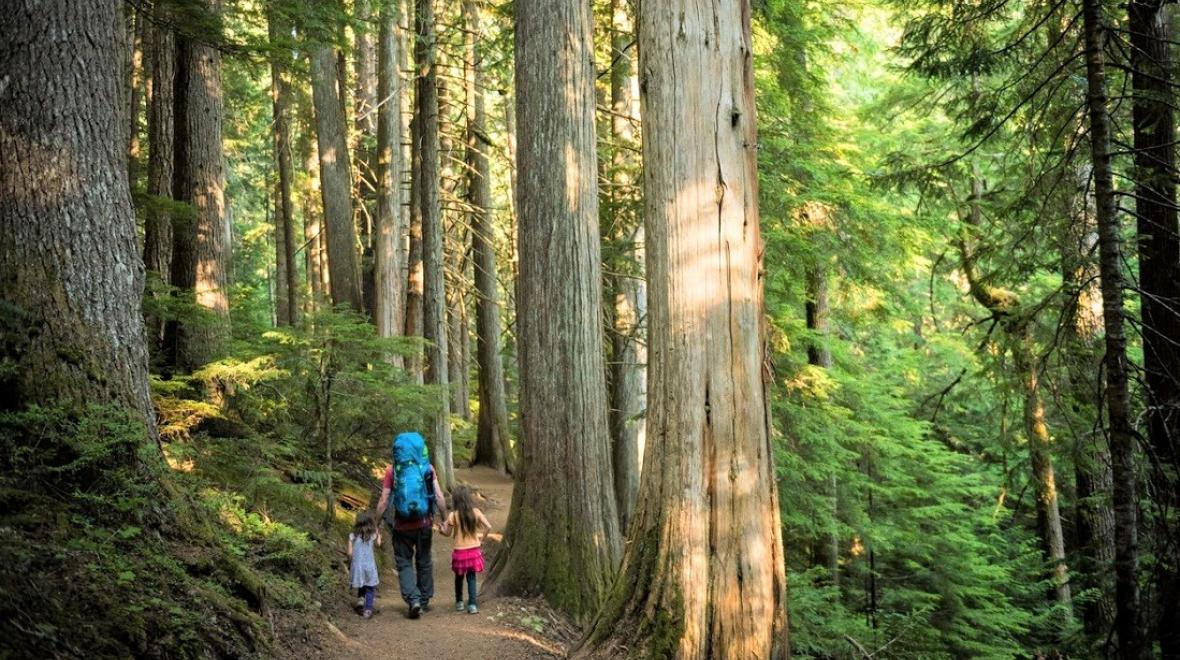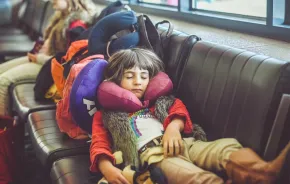
Summer is nearly here, and many families are excitedly planning camping, hiking and other outdoor adventures. As with any undertaking in the wilderness — especially with kids — thinking ahead about safety pays off.
A few years ago, we spoke with local hiking dad Mike Loney about his top safety tips for families out on the trail. Loney has volunteered since 2002 with Snohomish County Volunteer Search and Rescue (SCVSAR). His experiences as a dad and a rescuer give him a dual perspective on how to prepare for hiking and camping with kids. Here are some of his top recommendations on gearing up, what to do if a child gets lost and potential dangers to watch out for. Plus, we’ve included what to do if you encounter a wild animal.
Get the right gear for kids and train them how to use it.
The first thing to consider, Loney says, is that each child should have a whistle around his or her neck, plus a pack filled with rain gear, a warm hat, gloves, food and water. Add to that a space blanket to wrap around them and a seat pad to keep them off the wet and cold ground.
Loney notes that children as young as preschool-age can carry a pack containing these items, which are relatively light. Many kids feel important carrying some of their own gear, and parents will find many child-specific packs to choose from at REI and other outdoor retailers.
Before the hike, teach kids how to pull out the sit pad, put their warm clothes on and open up the space blanket and wrap themselves in it. If they have a headlamp or flashlight in their pack, teach them how to turn it on.
Adults, of course, should also carry these items in addition to the Ten Essentials.
Know what to do if kids get separated from you
Take time before the hike to train children on what to do if they get separated from parents while in the woods and how to use the tools in their pack. First, they should find a tree and stay near it. People are easier to find when they stay put. “Hug a tree and stay there; that tree is your friend,” says Loney. “By saying ‘find a tree that’s going to be a friendly tree,’ it becomes like a stuffed animal, and they are more likely to latch onto that tree and stay in place.”
Once situated by a tree, kids should use the whistle. A whistle is important, Loney says, because it is very hard to find people in the woods by voice alone. A whistle’s sound travels much farther, and people can keep whistling for much longer than they can keep yelling for help. It’s not necessary to teach children a specific SOS call; search and rescue volunteers will check out any whistle they hear. (Washington Trails Association recommends teaching them to whistle three short blasts, and then count to three before whistling again.)
Reassure children that they will not be in trouble if they get lost; many children are reluctant to call out in the woods because they are afraid of strangers or of being punished. Kids need to know that it’s okay to ask for help and to call out and answer if they hear strangers calling their name. If children are afraid of wild animals, blowing a whistle loudly can also help them feel that they are driving the animals away.
Repeat safety instructions with each hike to keep them fresh in your young explorer’s mind.
Know the trail and follow hiking safety rules
Before your hike, research the trail you’ve selected to understand what kind of potential hazards might exist on your chosen route. Washington Trails Association’s trip reports are a fantastic resource for this. Be sure to train kids to follow basic safety rules. Here are some best practices.
- Stay in sight. Tell children they need to be able to see parents at all times. Consider letting kids lead, with an adult bringing up the rear to keep an eye on everyone.
- Pay attention to the trail. Some mountain trails travel through avalanche chutes, or traverse steep slopes where debris might fall.
- Take extra precautions around water. Keep a constant eye on children when they are around water. Watch out for steep bank edges that drop into swift water and slippery cobbles that could cause children to lose footing. If wading, stick to very shallow areas with good footing, gentle current and a safe entry point.
- Tune in to teens. Loney warns that teenagers need special guidance, as they tend to be more fearless. Many teens get into trouble by climbing in off-limits areas. In his search and rescue work, he’s had several rescues where people tumbled down steep slopes, and once they started sliding, they picked up speed and couldn’t stop.
- Look back so you don’t get lost. While on the trail, take time to look back the way you’ve come. Trails look different when you turn around, and junctions are especially important places to get a picture of in your mind to recall the way to go. Remind kids to always wait at trail forks.
- Carry mapping tools: Parents should carry a map and compass or a GPS device, and know how to use them.
Prevent (and watch for signs of) hypothermia and dehydration
Know and watch out for the signs of hypothermia and dehydration. “Probably the single most important hypothermia sign in children is shivering,” says Loney. “And that’s the time to do something, because if it progresses beyond that, then hypothermia is actually pretty hard to reverse out in the field.” Further symptoms can include lethargy, lapses in judgment or becoming very clumsy and unable to do activities involving fine motor skills.
The first step to avoiding hypothermia, Loney says, is to wear proper outdoor clothing. Avoid jeans and cotton hoodies; instead, have kids wear synthetic or fleece clothes. Make sure kids are equipped with waterproof shells. These don’t have to be top-of-the-line; many items can be found at thrift and discount stores. Warm hats and gloves can make a big difference, too.
Consider carrying a stove or a thermos to make a hot drink, especially in the colder months. Feed children high-energy, high-carb food that will convert quickly to energy and heat. If children are showing any signs of hypothermia, stop the hike and head back to the car.
To prevent dehydration, which Loney says he has seen more of on his rescues than hypothermia, parents need to be proactive about reminding children (and themselves) to drink often, especially on hot days.
Signs of dehydration include flush sweating. “It is one of the first things you might notice when it’s too hot, or they’re not getting enough fluids,” he says. “They’ll be warm to the touch and sweaty, lethargic — they reach a point where they have to sit down and stop.” If you notice these signs, “intervene sooner rather than later,” he says.
Making sure everyone is outfitted with the proper gear and taking time to train kids in simple survival skills will make a big difference if you ever encounter trouble on the trail. Hopefully you’ll never need to call a Search and Rescue team to come bail you out, but if you do, you’ll be in better shape when they get to you.
What to do if you encounter a wild animal:The Washington Department of Fish & Wildlife provides these basic strategies for dealing with encounters with potentially dangerous wildlife. For more detailed information, consult the WDFW website. If you encounter a bear:
If you encounter a cougar (also called a mountain lion):
If you encounter a coyote:
ParentMap’s top hiking articles — dozens of great hikes to do with kids! |
Editor’s note: This article was originally published several years ago and updated most recently for 2023.












